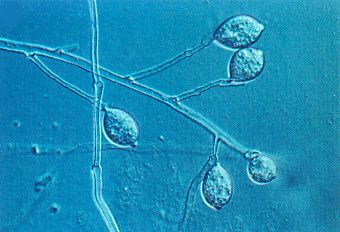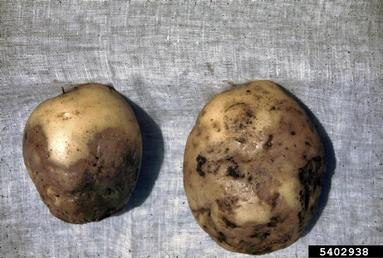

What can those working in this field do? Farmers, who have treated their seed potatoes with Cuprozin progress against bacterial soft rot (Erwinia) with the ULV-method (Mantis implement) can count on a side effect against an initial infection (stem infection) of Phytophthora. Sites with a high ground-water level and areas with high rainfall are especially endangered by a very early and massive infestation of the stems. Light soils drain water faster and the danger of an early and heavy infestation is considerably lower than on loamy soils. But also the soil type indirectly affects the progress of the disease. This is why in years with dry weather in spring a considerably lower initial infestation and with that a lower impact of infections occurs than in humid years. In both cases the plants show an infestation of the stem very early (initial infestation). They will grow up diseased as well and typical Phytophthora nests develop. This is how neighbouring plants or stems of the same plant can be infected. Spores develop on the diseased tuber and are distributed via soil water. Extensive research activities at the Bavarian State Research Centre of Agriculture (LfL) in recent years have shown that with high soil moisture another way of infection is possible (fig. When these potatoes start growing in spring the fungus expands into the stem. Remove and destroy volunteers as well as any potatoes that have been culled.The late blight pathogen (Phytophtera infestans) hibernates in latently (not visibly) infected potato tubers. Even when resistant cultivars are used, an application of fungicide may be warranted.
#Late blight of potato disease free
Use only certified disease free seed and resistant cultivars where possible. It is transmitted to newly emerging plants to produce airborne spores which then transmit the disease to nearby plants. infestans, including those in storage, volunteers, and seed potatoes. Infected tubers are the primary source of the pathogen P. These lesions are usually at the juncture of the leaf and stem where water collects or on leaf clusters at the top of the stem. The foliage of the plant will have dark water soaked lesions surrounded by white spore and the stems of infected plants will be afflicted with brown, greasy looking lesions. Often, when the tubers are infected with late blight, they are left open to secondary bacterial infections which may make diagnosis difficult. When inspected further by cutting into the tuber, reddish-brown dry rot can be observed. Initial symptoms of late blight include purplish-brown lesions on the surface of the potatoes. Infected plants may be killed off within a couple of weeks from infection. This fungal disease is fostered by periods of cool, wet weather. Primarily a disease of potatoes and tomatoes, late blight may affect other members of the Solanaceae family as well. Late blight of potatoes is caused by the pathogen Phytophthora infestans.

Potatoes with late blight are still considered to be a serious disease so it’s important for growers to learn about treating potato late blight in the garden. You may know it better from the Irish potato famine of the 1840’s that resulted in the starvation of over a million people along with a mass exodus of those who survived. What’s potato late blight – only one of the most historically devastating diseases of the 1800’s. Even if you don’t realize it, you have probably heard of late blight of potatoes.


 0 kommentar(er)
0 kommentar(er)
